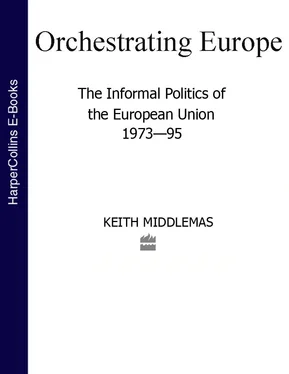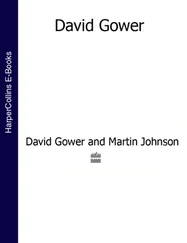But for the political elites in each member state, and the Brussels milieu, the Delors peak came a year earlier; the factor which merited blame was that the IGC was ill-conceived, badly prepared and badly conducted, not on EMU, but on the political side. There was, for example, no central EU body like the Spaak Committee and no think-tank to prepare what actually went on at Maastricht; ministers went into the negotiating chambers often without full texts, in a changing set of circumstances. But the fault lay not only with the Commission’s excess of zeal to get everything included: ministers were equally over-ambitious, for instance in their desire to merge CFSP and defence.
Spain’s entry in 1986 also introduced a novel element, for Spain rapidly became not only a major beneficiary but an increasingly adept player. The Gonzalez government focused on a narrow set of aims, clearly intending to take its place alongside the existing big four 8– an outcome which seemed to have taken place after Spain joined the ERM in 1989, but above all in the triumphal year 1992 of Expo-Seville, Madrid’s tenure as Europe’s cultural capital, and the Barcelona Olympic Games.
The Spanish phenomenon also highlighted what was initially a less obvious part of the grand design: the extension of regional funding from a policy of subsidizing poor areas, such as Italy’s Mezzogiorno and most of Greece (often without tangible returns), to one by DG16 intended to raise the standards of infrastructure, production, investment and commerce to those of the rich core. This gave the well-organized, politically articulate regional governments in Catalonia and northern Italy their cue to ask for political as well as financial recognition when the IGCs began work.
Member states’ consent for the agenda and the Delors II agenda budget which was to pay for it depended on resolving a string of apparently unrelated issues in the two years before Maastricht. This was the harder to deliver since the Twelve no longer grouped in broad agreement, as they had on the Single Act, but divided into aggregations, northern or Mediterranean, large and small, rich and poor, those with great bargaining skills and those with less. Generally in this period it suited the ‘northern’ members to appease Mediterranean demands – in short for Germany to pay. Delors’s appointment of three liberal-minded Commissioners to the principal jobs in January 1989 (Leon Brittan to DG4, Martin Bangemann to DG3, Frans Andriessen to DG1, while keeping the protectionists Manuel Marin (Spain) at Fisheries, and Vasso Papandreou (Greece) at Social Affairs) may have encouraged them to do so.
The two principal issues need to be treated separately: monetary union first, then ‘political cooperation’ (foreign policy and defence), together with the whole area of the ‘interior ministry matters’ – policing of borders, cooperation on crime, terrorism, drugs and illegal immigration – which came together as a result of much wider developments in Europe and ‘near-Europe’. All were, of course, contingent on achievement of the single market. But the Commission could integrate the agenda and take a leading role only on the first of these; the other two touched on member states’ sovereignty far more directly and had to be argued out by ministers and heads of government in the context of a Europe that was changing, after the collapse of Soviet power, more rapidly than at any time since establishment of the ‘Peoples’ Democracies’ had cut old Europe in two in the late 1940s. Even France and Germany could not agree on the details of so wide a range.
On both aspects, the Commission lacked the force to recreate the coherent agenda that had been given it earlier by industrial and financial organizations in Brussels and member state’s capitals during the single market negotiations. These players did not lack interest, but they tended to dispute the agenda among themselves, with those expecting advantages in the internal market facing up to the still-protected national champions, secure for the present in their state aids and government procurement contracts. On the question of Japanese car imports for example, the old peak organization actually broke up, to reform itself under a new title and without one of France’s leading producers (see chapter 10). Apart from these relatively novel rivalries, firms and financial institutions were already deeply engaged in preparing for 1992’s consequences – to which monetary union seemed a remote adjunct; main boards were more concerned with the wave of mergers and acquisitions which reached its apogee in 1988–90. 9
Organizations such as ERT and the European Committee of AmCham still argued the industrial point of view, especially on monetary union, but managements across Europe did not seek direct inputs to the IGC and appear not to have followed their course in detail. They reacted to the post-Maastricht crisis as if the world had changed little since the Single Act. The ERT, which did succeed in getting some of its ideas into the Maastricht texts, continued to publish pamphlets such as ‘Rebuilding confidence, an action plan for Europe’ (December 1992), which prescribed neo-Keynesian remedies for revival and employment, with talk of ‘concerted action’ and ‘strong leadership’ by governments in partnership with industry, as if the 1988–90 harmony between member states still existed. 10
The agenda for the IGC was very much more complex than in 1985 because of the range of issues it had to consider, and the diversity – often incompatibility – of outlooks among member state governments. Heads of government and the Commission, often as rivals, therefore developed the agenda at one remove from the corporate players (who restricted themselves to monetary union and its consequences), and at several removes from national parliaments, media and the public. As a result, the long-running process was shaped by bargains, trade-offs and concessions which were different in kind from those of the internal market IGC in 1985. This may not have been intended to be an evasion of public debate, for many of the issues genuinely appeared too complex to explain in straightforward language, or were too confidential. But what, in retrospect, seems a clear failure of all those in the negotiations to educate their publics, meant that the new treaties, launched in 1992 in very altered circumstances, would shock public opinion – notably in Denmark, France and Britain.
There is no need to re-tell in any detail the Soviet Union’s collapse, the failure of former People’s Democracies (which began when Hungary opened its border with Austria to East Germans fleeing to the West and ended with the collapse of Communist authority in Prague and breach of the Berlin Wall on 9 November 1989), nor the reunification of the two Germanies. But all three events conditioned everything that happened in Europe thereafter. They affected EFTA, as Sweden and Finland reacted both to the removal of a forty-year-long threat and to the new-found independence of the Baltic States and Austria, with the return of growing normality, to what had once been Habsburg dominions. Above all they affected former West Germany and France, the EC’s central nexus, because the implications of a united Germany encompassed all the other eleven. The break-up of Yugoslavia, the collapse of Christian Democracy in Italy, and the undermining of the political right in Britain can be traced to the same origin, as can the growth of largely refugee immigration through east and south east Europe’s porous borders, with its direct consequences of racism and xenophobic nationalism.
In the years 1989–93, many of the vestiges of post-War settlements, in welfare programmes, industrial relations and state benefits, also died. Each country described its own parabola of declension: the new – or perhaps nineteenth-century Liberal – thought, first enunciated by the new right in Britain and the United States, passed through a sort of contagion, causing questioning, then fiscal and moral panics, and finally a scaling down of promises and expectations. The true fiscal crisis of European states, heralded in academic literature in the early 1980s, burst a decade later. Coinciding with disillusion after Maastricht, it had a corrosive effect on what remained of late-1980s’ aspirations.
Читать дальше









![Brian Thompson - A Monkey Among Crocodiles - The Life, Loves and Lawsuits of Mrs Georgina Weldon – a disastrous Victorian [Text only]](/books/704922/brian-thompson-a-monkey-among-crocodiles-the-life-thumb.webp)


